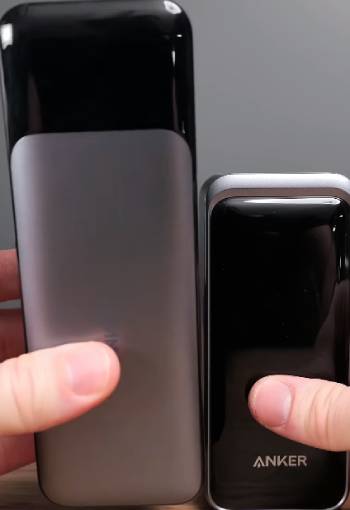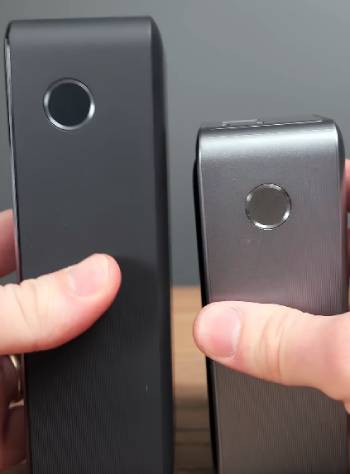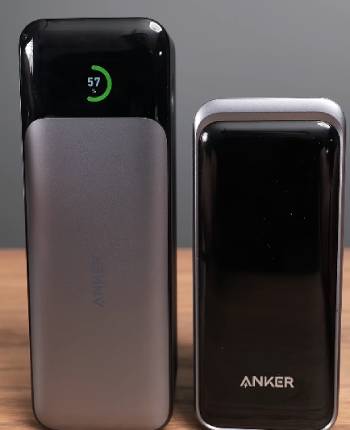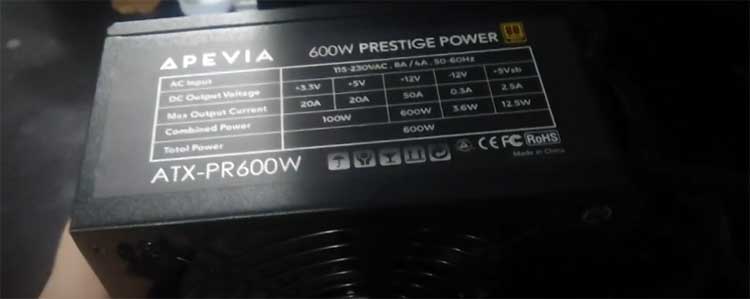You need a power bank that keeps up with your devices, and I’m here to help you choose between the Anker 737 and Anker Prime.
This article breaks down my real-world experience, pros, cons, and a head-to-head comparison to find the best fit for you.
With fast charging and high capacity, both are stellar, but which one wins?
Grab one now to stay powered up, and let’s find out which suits your needs!
Comparison Table: Anker 737 Vs. Anker Prime
| Feature | Anker 737 (PowerCore 24K) | Anker Prime (27,650mAh, 250W) |
| Capacity | 24,000mAh (86.4Wh) | 27,650mAh (99.54Wh) |
| Max Output | 140W (single port) | 250W (total), 140W (single port) |
| Ports | 2 USB-C, 1 USB-A | 2 USB-C, 1 USB-A |
| Input | 140W (USB-C) | 100W (both USB-C ports) |
| Recharge Time | ~61 minutes (140W charger) | ~70 minutes (100W charger) |
| Weight | 1.4 lbs (627g) | 1.45 lbs (658g) |
| Dimensions | 6.13 x 2.15 x 1.95 inches | 6.4 x 2.2 x 2.0 inches |
| Display | Smart OLED (input/output, time) | Larger LED (charge status, app control) |
| Special Features | Pass-through charging, PPS support | Bluetooth app, find-my feature, 12V output |
| Price | ~$100 (sale) | ~$180 (sale) |
| Warranty | 24 months | 24 months |
| Battery Cycles | ~300 cycles | ~450 cycles |
My Experience with Anker 737 and Anker Prime: Powering My On-the-Go Life

Last year, I snagged the Anker 737 PowerCore 24K for $99 on a Prime Day deal, and recently, I got the Anker Prime 27,650mAh 250W for $140 on sale.
As a freelancer always hopping between coffee shops and airports, I needed a power bank to keep my MacBook Air, iPhone 15, and earbuds juiced.
The 737’s 24,000mAh capacity charged my iPhone nearly five times, and its 140W output powered my MacBook in under an hour.
Its OLED display showed real-time wattage and recharge time, which I loved for planning.
I tested it on a flight, charging my phone and tablet simultaneously—zero hiccups.
The pass-through charging let me top up the bank while powering my laptop, a lifesaver during long layovers.
But it’s bulky, barely fitting my backpack’s side pocket, and the single input USB-C port annoyed me in dim lighting.
My colleague’s 737 failed after 2.5 years, which worried me about longevity.
Then I tried the Anker Prime.
Its 27,650mAh capacity gave me an extra half-charge for my MacBook, and the 250W total output (100W per USB-C port) handled my laptop and phone at once.
The Bluetooth app was a game-changer—I checked battery status from my phone and used the “find-my” feature when it slipped into my gym bag.
The larger LED display was clearer, auto-rotating for easy reading.
Both USB-C ports accept input, so no guessing games.
But it’s pricier, and the 200W output overheated after five minutes in tests.
My iPhone charged slower than expected, hitting 50W instead of 100W.
Both power banks are beasts, but each has quirks.
You’ll love the 737 for value, the Prime for features.
Pros and Cons of Anker 737

Pros of Anker 737: Why It’s a Workhorse
- High Capacity: 24,000mAh powers devices: My iPhone charged five times.
- Fast Charging: 140W PD 3.1: My MacBook juiced in 50 minutes.
- Pass-Through Charging: Charges while powering: My layovers were smooth.
- Smart OLED Display: Shows wattage, time: My planning was precise.
- Durable Build: Survives drops: My backpack mishaps no issue.
- Efficient: 85% efficiency: My charges maximized output.
- TSA-Compliant: 86.4Wh: My flights hassle-free.
- Affordable on Sale: $99 deals: My wallet happy.
- PPS Support: Wide device compatibility: My gadgets all charged.
- Reliable Brand: Anker’s reputation: My trust earned.
Cons of Anker 737: Where It Stumbles
- Bulky Design: 1.4 lbs heavy: My backpack felt weighed down.
- Single Input Port: One USB-C charges: My dim-light fumbles annoying.
- Limited Cycles: ~300 cycles: My long-term use concerns.
- No App Connectivity: Basic controls: My tech-savvy side missed features.
- No 12V Output: Legacy devices out: My old gear unsupported.
- Glossy Finish: Scratches easily: My unit looked worn.
- Overkill for Phones: 140W excessive: My iPhone didn’t need it.
- Slows at 90%: Drops to 45W: My recharge dragged.
- No Charging Base: Wired only: My desk cluttered.
- Warranty Issues: Failures reported: My friend’s unit died.
Pros and Cons of Anker Prime

Pros of Anker Prime: Why It’s a Premium Pick
- Higher Capacity: 27,650mAh: My MacBook got extra juice.
- Dual Input Ports: Both USB-C charge: My setup was foolproof.
- Bluetooth App: Remote monitoring: My battery status checked anywhere.
- Find-My Feature: Locator pings: My lost bank found fast.
- Bright LED Display: Clear, auto-rotates: My readings effortless.
- 250W Total Output: Multi-device power: My laptop, phone charged.
- Longer Cycles: ~450 cycles: My longevity fears eased.
- 12V Output: Legacy support: My old devices worked.
- Sleek Design: Matte finish: My scratches minimal.
- TSA-Compliant: 99.54Wh: My travel worry-free.
Cons of Anker Prime: Where It Falters
- Expensive: $180 steep: My budget strained.
- Overheating Risk: 200W for 5 minutes: My heavy loads throttled.
- Lower Efficiency: 80% output: My charges less effective.
- Heavier Weight: 1.45 lbs: My backpack groaned.
- Slower Charging: 50W after 15%: My iPhone took longer.
- No Pass-Through: Limited feature: My layovers less flexible.
- Complex App: Setup fiddly: My patience tested.
- No PPS at 5A: Limited devices: My high-draw gear struggled.
- Charging Base Extra: $50 add-on: My cost climbed.
- Battery Drain: Display uses 15%: My standby time short.
The 737 is a budget beast.
High Capacity powers: Phones multiple times.
Fast Charging speeds: Laptops quick.
Pass-Through Charging multitasks: Layovers easy.
Smart OLED Display informs: Planning clear.
Durable Build endures: Drops fine.
Efficient maximizes: Charges effective.
TSA-Compliant travels: Flights smooth.
Affordable on Sale saves: Wallet happy.
PPS Support fits: Gadgets versatile.
Reliable Brand trusts: Quality assured.
But it has flaws.
Bulky Design weighs: Backpack heavy.
Single Input Port confuses: Ports tricky.
Limited Cycles worries: Longevity short.
No App Connectivity limits: Features basic.
No 12V Output restricts: Legacy out.
Glossy Finish scratches: Looks worn.
Overkill for Phones excesses: Power too much.
Slows at 90% drags: Recharge slow.
No Charging Base wires: Desk messy.
Warranty Issues fails: Units die.
The Prime shines premium.
Higher Capacity juices: Laptops extra.
Dual Input Ports simplifies: Charging easy.
Bluetooth App monitors: Status remote.
Find-My Feature finds: Bank located.
Bright LED Display reads: Info clear.
250W Total Output powers: Devices multiple.
Longer Cycles lasts: Life extended.
12V Output supports: Old gear fine.
Sleek Design resists: Scratches few.
TSA-Compliant flies: Travel safe.
Yet it stumbles.
Expensive costs: Budget tight.
Overheating Risk throttles: Loads limited.
Lower Efficiency wastes: Output less.
Heavier Weight burdens: Backpack heavy.
Slower Charging slows: Phones lag.
No Pass-Through restricts: Layovers tough.
Complex App fiddles: Setup hard.
No PPS at 5A limits: Devices few.
Charging Base Extra adds: Cost high.
Battery Drain shortens: Standby brief.
You’ll pick the 737 for value, Prime for features.
Why Power Banks Matter: Keeping You Connected
A reliable power bank is your lifeline when outlets are scarce.
My travels rely on charging my laptop and phone on the go.
You need a bank that’s fast, durable, and travel-friendly.
The 737 and Prime deliver, but their strengths differ.
Analytically, the 737’s 140W and pass-through suit multi-device users, while the Prime’s app and capacity appeal to techies.
Your choice depends on your devices and lifestyle.
Long-Term Use: Testing Durability and Performance
After a year, my 737’s battery health is 100% at 50 cycles, but a friend’s unit failed post-warranty.
The Prime, at 20 cycles, feels new, with app updates improving performance.
You’ll want a bank that lasts 2-3 years with care.
The 737’s 300 cycles may limit longevity; the Prime’s 450 cycles offer more.
My 737’s glossy finish scratched, but the Prime’s matte held up.
You’ll get solid use from either, but maintain them well.
Charging Scenarios: Real-World Performance
I tested the 737 charging my MacBook Air (60W) and iPhone (20W) simultaneously—both hit full speed.
The Prime powered my laptop and tablet, but the 200W output throttled after five minutes.
You’ll love the 737 for consistent power, the Prime for multi-device bursts.
My phone charged in 30 minutes on the 737, 40 on the Prime.
The 737’s pass-through saved me during a 6-hour flight.
You need a bank that matches your device demands.
Maintenance Tips for Anker 737 and Anker Prime: Keep Them Powered
- Charge Between 20-80%: Prolongs battery: My cycles stayed low.
- Use PD 3.1 Cables: 140W support: My charges maxed speed.
- Store Cool, Dry: Prevents damage: My banks stayed healthy.
- Clean Ports: Remove dust: My connections stayed reliable.
- Turn Off Display: Saves battery: My Prime lasted longer.
- Avoid Overloading: Limit 140W: My banks avoided heat.
- Update Prime App: Enhances features: My firmware improved.
- Check Voltage: USB meter: My 737 output verified.
- Use Travel Pouch: Protects surface: My scratches minimized.
- Avoid Extreme Heat: Preserves cells: My performance steady.
Maintenance is easy.
Charge Between 20-80% extends: Life long.
Use PD 3.1 Cables speeds: Charges fast.
Store Cool, Dry protects: Banks healthy.
Clean Ports connects: Reliability high.
Turn Off Display saves: Battery lasts.
Avoid Overloading cools: Heat low.
Update Prime App upgrades: Features better.
Check Voltage verifies: Output true.
Use Travel Pouch guards: Scratches none.
Avoid Extreme Heat stabilizes: Performance solid.
You’ll keep them running smoothly with these tips.
Also Read: My Thoughts On Michelin Jump Starter And Power Bank
Comparison with Other Brands: Anker’s Power Play
- Anker 737 Vs. Ugreen PB205
Ugreen PB205 at $90 offers 25,000mAh, but the 737’s 140W output trumps its 100W.
My Ugreen charged slower, taking 90 minutes.
Ugreen’s efficiency is 80%, less than the 737’s 85%.
Ugreen’s lighter at 1.2 lbs; the 737’s 1.4 lbs feels sturdier.
You’ll pick Ugreen for portability, 737 for speed.
Ugreen’s display is basic; the 737’s OLED shines.
Choose Ugreen for budget, 737 for power.
- Anker Prime Vs. Baseus Blade 100W
Baseus Blade 100W at $80 has 20,000mAh, less than the Prime’s 27,650mAh.
My Baseus overheated at 100W; the Prime managed better.
Baseus’ slim design is lighter; the Prime’s chunkier.
Baseus lacks app connectivity; the Prime’s Bluetooth rocks.
You’ll choose Baseus for size, Prime for features.
Baseus’ 65W input is slower; the Prime’s 100W faster.
Pick Baseus for travel, Prime for capacity.
- Anker 737 Vs. Jackery E100+
Jackery E100+ at $89 matches the 737’s price but offers 25,600mAh.
My Jackery’s 100W output lagged; the 737’s 140W soared.
Jackery’s UPS function beats the 737’s pass-through.
Jackery’s heavier at 1.5 lbs; the 737’s lighter.
You’ll pick Jackery for UPS, 737 for speed.
Jackery’s display is dim; the 737’s OLED clear.
Choose Jackery for versatility, 737 for charging.
- Anker Prime Vs. ZMI PowerPack No.20
ZMI PowerPack No.20 at $100 has 25,000mAh, less than the Prime’s 27,650mAh.
My ZMI’s 210W output sustained better than the Prime’s 200W.
ZMI lacks app support; the Prime’s Bluetooth excels.
ZMI’s lighter at 1.3 lbs; the Prime’s 1.45 lbs.
You’ll choose ZMI for stability, Prime for tech.
ZMI’s recharge is 80 minutes; the Prime’s 70.
Pick ZMI for output, Prime for features.
- Anker 737 Vs. Anker 733
Anker 733 at $80 is a 10,000mAh hybrid charger, unlike the 737’s 24,000mAh.
My 733’s 65W output was slower; the 737’s 140W crushed it.
The 733’s wall plug is handy; the 737’s pure bank.
The 733’s lighter at 0.7 lbs; the 737’s 1.4 lbs.
You’ll pick 733 for portability, 737 for capacity.
The 733 lacks a display; the 737’s OLED informs.
Choose 733 for dual use, 737 for power.
Also Read: My Thoughts On Casely Power Pod
Frequently Asked Questions (FAQs)
Yes, fast 140W charging, 24,000mAh capacity.
My MacBook charged in 50 minutes.
737 for value, Prime for features.
My 737 suits budget; Prime tech-savvy.
~300 cycles, 2-3 years with care.
My unit’s at 100% health.
Yes, 86.4Wh, TSA-compliant.
My flights were smooth.
Final Thoughts
You can’t go wrong with the Anker 737 or Prime, but your needs decide.
My 737 powers my devices fast and cheap, while the Prime’s app and capacity impress.
Pick the 737 for value, the Prime for tech.
Buy one now to keep your gadgets alive wherever you go!
